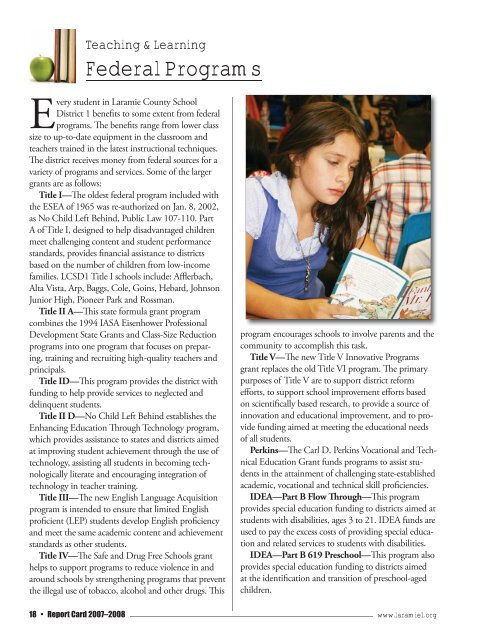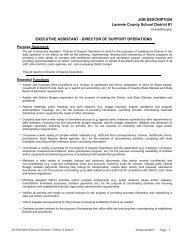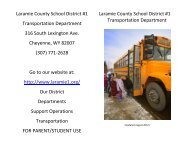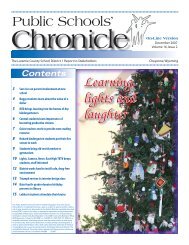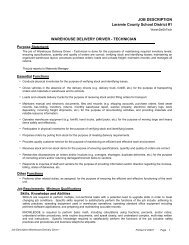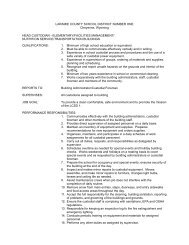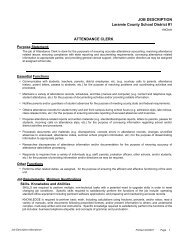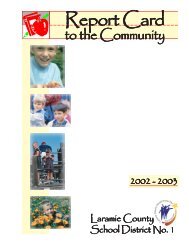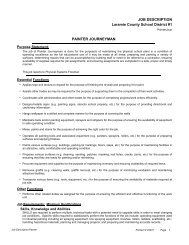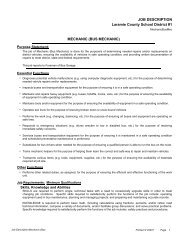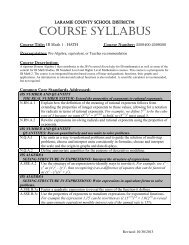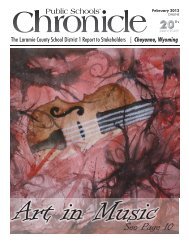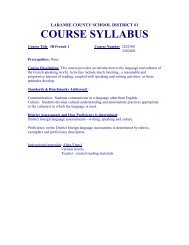and Strategic Initiatives 2008â2009 - Laramie County School District ...
and Strategic Initiatives 2008â2009 - Laramie County School District ...
and Strategic Initiatives 2008â2009 - Laramie County School District ...
Create successful ePaper yourself
Turn your PDF publications into a flip-book with our unique Google optimized e-Paper software.
Teaching & Learning<br />
Federal Programs<br />
Every student in <strong>Laramie</strong> <strong>County</strong> <strong>School</strong><br />
<strong>District</strong> 1 benefits to some extent from federal<br />
programs. The benefits range from lower class<br />
size to up-to-date equipment in the classroom <strong>and</strong><br />
teachers trained in the latest instructional techniques.<br />
The district receives money from federal sources for a<br />
variety of programs <strong>and</strong> services. Some of the larger<br />
grants are as follows:<br />
Title I—The oldest federal program included with<br />
the ESEA of 1965 was re-authorized on Jan. 8, 2002,<br />
as No Child Left Behind, Public Law 107-110. Part<br />
A of Title I, designed to help disadvantaged children<br />
meet challenging content <strong>and</strong> student performance<br />
st<strong>and</strong>ards, provides financial assistance to districts<br />
based on the number of children from low-income<br />
families. LCSD1 Title I schools include: Afflerbach,<br />
Alta Vista, Arp, Baggs, Cole, Goins, Hebard, Johnson<br />
Junior High, Pioneer Park <strong>and</strong> Rossman.<br />
Title II A—This state formula grant program<br />
combines the 1994 IASA Eisenhower Professional<br />
Development State Grants <strong>and</strong> Class-Size Reduction<br />
programs into one program that focuses on preparing,<br />
training <strong>and</strong> recruiting high-quality teachers <strong>and</strong><br />
principals.<br />
Title ID—This program provides the district with<br />
funding to help provide services to neglected <strong>and</strong><br />
delinquent students.<br />
Title II D—No Child Left Behind establishes the<br />
Enhancing Education Through Technology program,<br />
which provides assistance to states <strong>and</strong> districts aimed<br />
at improving student achievement through the use of<br />
technology, assisting all students in becoming technologically<br />
literate <strong>and</strong> encouraging integration of<br />
technology in teacher training.<br />
Title III—The new English Language Acquisition<br />
program is intended to ensure that limited English<br />
proficient (LEP) students develop English proficiency<br />
<strong>and</strong> meet the same academic content <strong>and</strong> achievement<br />
st<strong>and</strong>ards as other students.<br />
Title IV—The Safe <strong>and</strong> Drug Free <strong>School</strong>s grant<br />
helps to support programs to reduce violence in <strong>and</strong><br />
around schools by strengthening programs that prevent<br />
the illegal use of tobacco, alcohol <strong>and</strong> other drugs. This<br />
program encourages schools to involve parents <strong>and</strong> the<br />
community to accomplish this task.<br />
Title V—The new Title V Innovative Programs<br />
grant replaces the old Title VI program. The primary<br />
purposes of Title V are to support district reform<br />
efforts, to support school improvement efforts based<br />
on scientifically based research, to provide a source of<br />
innovation <strong>and</strong> educational improvement, <strong>and</strong> to provide<br />
funding aimed at meeting the educational needs<br />
of all students.<br />
Perkins—The Carl D. Perkins Vocational <strong>and</strong> Technical<br />
Education Grant funds programs to assist students<br />
in the attainment of challenging state-established<br />
academic, vocational <strong>and</strong> technical skill proficiencies.<br />
IDEA—Part B Flow Through—This program<br />
provides special education funding to districts aimed at<br />
students with disabilities, ages 3 to 21. IDEA funds are<br />
used to pay the excess costs of providing special education<br />
<strong>and</strong> related services to students with disabilities.<br />
IDEA—Part B 619 Preschool—This program also<br />
provides special education funding to districts aimed<br />
at the identification <strong>and</strong> transition of preschool-aged<br />
children.<br />
18 • Report Card 2007–2008 www.laramie1.org


